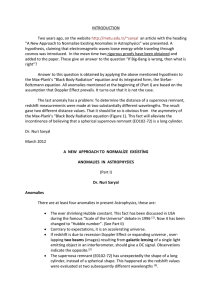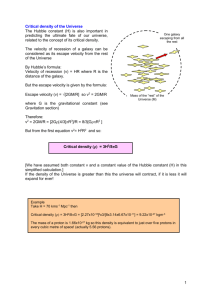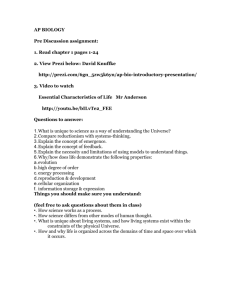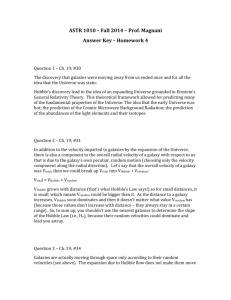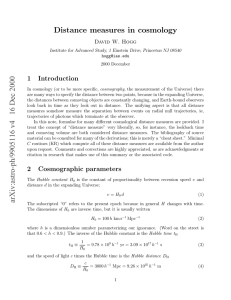(7 ln (z +1)
advertisement
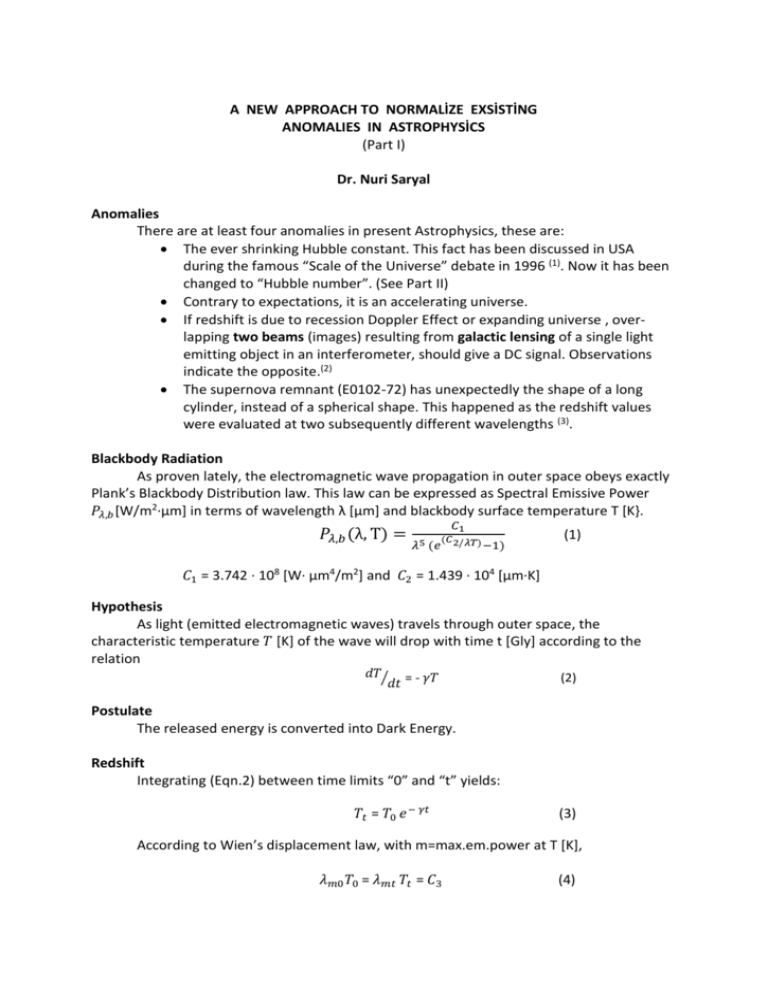
A NEW APPROACH TO NORMALİZE EXSİSTİNG ANOMALIES IN ASTROPHYSİCS (Part I) Dr. Nuri Saryal Anomalies There are at least four anomalies in present Astrophysics, these are: The ever shrinking Hubble constant. This fact has been discussed in USA during the famous “Scale of the Universe” debate in 1996 (1). Now it has been changed to “Hubble number”. (See Part II) Contrary to expectations, it is an accelerating universe. If redshift is due to recession Doppler Effect or expanding universe , overlapping two beams (images) resulting from galactic lensing of a single light emitting object in an interferometer, should give a DC signal. Observations indicate the opposite.(2) The supernova remnant (E0102-72) has unexpectedly the shape of a long cylinder, instead of a spherical shape. This happened as the redshift values were evaluated at two subsequently different wavelengths (3). Blackbody Radiation As proven lately, the electromagnetic wave propagation in outer space obeys exactly Plank’s Blackbody Distribution law. This law can be expressed as Spectral Emissive Power 𝑃𝜆,𝑏 [W/m2·μm] in terms of wavelength λ [μm] and blackbody surface temperature T [K}. 𝑃𝜆,𝑏 (λ, T) = 𝐶1 (𝐶 𝜆5 (𝑒 2/𝜆𝑇) −1) (1) 𝐶1 = 3.742 · 108 [W· μm4/m2] and 𝐶2 = 1.439 · 104 [μm·K] Hypothesis As light (emitted electromagnetic waves) travels through outer space, the characteristic temperature 𝑇 [K] of the wave will drop with time t [Gly] according to the relation 𝑑𝑇⁄ = - 𝛾𝑇 𝑑𝑡 (2) Postulate The released energy is converted into Dark Energy. Redshift Integrating (Eqn.2) between time limits “0” and “t” yields: 𝑇𝑡 = 𝑇0 𝑒 − 𝛾𝑡 (3) According to Wien’s displacement law, with m=max.em.power at T [K], 𝜆𝑚0 𝑇0 = 𝜆𝑚𝑡 𝑇𝑡 = 𝐶3 (4) 𝐶3 = 2897.6 [μm·K] Combining the last two equations yields the redshift equation for𝜆𝑚 : (See Fig.1 below) 𝜆𝑚𝑡 = 𝜆𝑚0 𝑒 𝛾𝑡 (5) As the characteristic temperature drops, the wave length increases as a function of time. Taking z = 8 (i.e. 𝜆𝑡 /𝜆0 = 9) and t = 13.7 [Gyr] values as basis, gives 𝛾 = 0.1604 [𝐺𝑦𝑟 − 1]. Using eqns. 1, 4 and 5, the following relation, expressing the time (distance) dependence of emissive power of the emitted light can be obtained: 𝑃𝑚𝑡 = 𝑃𝑚0 𝑒 − 5𝛾𝑡 (6) Fig.1 Spectral blackbody emissive power (4) Dashed line, connecting all 𝑷𝒎 values indicates the “blackbody redshift line” (Eqn. 3 & 5). Verification Equation 3 and therefore 5 describe exactly the blackbody redshift line. The character of equations 1, 5 and 6 gives a positive response to the above mentioned four anomalies. First anomaly mentioned is the “ever shrinking Hubble constant”. Taking equation 5 and the known “z” value, a corrected time (distance) value can be calculated by using ln(𝑧+1) t = 𝛾 [Gyr] (7) The results will hopefully bring the distance measurements using other methods (such as Cepheids) in close agreement. Redshift due to relative movement should be added. Second anomaly is the accelerating universe, concluding from SN 1a High z measurements. Brian Schmidt (5) mentions in his concluding words: “So our observations may mean one of three things: The Exciting: the universe is accelerated by some unknown type of matter that is spread throughout the Cosmos. The Heretical: General Relativity is as sacred as anything in Physics, but it may be wrong. Since our work is comparing the predictions of General Relativity with observations, if General Relativity is wrong, so are our conclusions. The Mundane (at least from our point of view): We are simply wrong and have been fooled by Supernovae into believing the Universe is accelerating. Maybe supernovae are fainter in the past, and therefore look further away.” The last sentence is exactly what (Eqn. 6) predicts: A strong decrease of emissive power for large “t” (distance) values! Third anomaly is the AC signal as a result of overlapping two images due to galactic lensing of a single source in an interferometer. One good example for such a galactic lensing could be a quasar, reported by Rudolph E. Schild of the Harvard Smithsonian Center for Astrophysics. The image of the quasar near the Big Dipper is split in two by the gravity of a massive galaxy. The time difference between the two brightness variations (one complete cycle is 417 light-days (2). Eqn.5 predicts an AC response, if two beams are of different length (asymmetric galactic lensing). Positive response to the fourth anomaly can be obtained by using (Eqn. 1 to 6), taking two substantially different wave lengths and calculation. Quotations: (1) 𝐻0 : The Incredible Shrinking Constant 1925-1975. Virginia Trimble, Publication of the Astronomical Society of the Pacific 108; 1073 – 1082 (2) Hourly Variability In Q0957]561 – Wesley N. Colley and Rudolph Schild The Astrophysical Journal, 540:104-112, 2000 September 1 (3) Internet: Astronomy Picture of the Day; 2009 Sept. 05 (4) Adopted from: Fundamentals of Heat and Mass Transfer, Frank P. Incropera and David P. de Witt, John Wiley & Sons (5) Dr. Brian Schmidt, leader of the Australian High-z SN 1a group. http://msowww.anu.edu.au/~brian/ Anomalies in Astrophysics (Part II) Age of the Universe has ever been a subject of primary interest. Big Bang theory, based on Hubble constant could not define a reliable age (1). If the hypothesis and the related equations proposed in (Part I) eliminate the mentioned anomalies, then the theory of “red shift due to recession velocity (Doppler effect or expanding Universe)” must be abandoned. A new theory, backed up by some astrophysical observations, could be as follows: Postulate: It is a recycling universe. Matter is converted into Dark Matter in Black holes. This postulate is backed up by the observations, indicating that Dark Matter is accumulated at central regions of galaxies. Size of Black holes is proportional to its matter accretion rate and this again to the size of galaxy. Dark matter condensates out into matter (Hydrogen). This postulate is backed up by Isotropic Cosmic Microwave Background Radiation and huge amounts of Hydrogen existing in outer space. (1) An Age Crisis? If we compare the two age determinations, there is a potential crisis. If the universe is flat, and dominated by ordinary or dark matter, the age of the universe as inferred from the Hubble constant would be about 9 billion years. The age of the universe would be shorter than the age of oldest stars. This contradiction implies that either 1) our measurement of the Hubble constant is incorrect, 2) the Big Bang theory is incorrect or 3) that we need a form of matter like a cosmological constant that implies an older age for a given observed expansion rate. Some astronomers believe that this crisis will pass as soon as measurements improve. If the astronomers who have measured the smaller values of the Hubble constant are correct, and if the smaller estimates of globular cluster ages are also correct, then all is well for the Big Bang theory, even without a cosmological constant. http://map.gsfc.nasa.gov/universe/uni_age.html Author’s mail address: saryal@metu.edu.tr http://www.metu.edu.tr/~saryal (Part III) Verification of the Hypothesis One anomaly mentioned in part one is the accelerating universe: During the early times of the universe, supernovae (SNe I a) appear to be fainter than expected. This fact is interpreted as an accelerating universe. A great number of astronomers from different countries worked on this “Supernova Cosmology Project” in two groups and published their results (Fig. 1) and (Ref. 1) Graph for the luminosity factor “μ” versus redshift value “z”. (Ref. 1 pp5) Empirical equations were proposed by different astrophysicists. Saul Perlmutter (UC Berkeley USA) has proposed the following equations: (Ref. 2 pp. 26) For z > 0.1 μ = m – M = 5 log 𝒅𝑳 - 5 For z < 0.1 μ = 5 log z + 5 log 𝒄 𝑯𝟎 + 25 where 𝒅𝑳 = √𝑳⁄𝟒𝝅𝑭 (𝒅𝑳 : The luminosity distance) Stating that luminosity will decrease with the square of the distance (𝑑𝐿 ). Data from the Supernova Cosmology Project is very useful to test and possibly verify the hypothesis stated in (Part I). According the hypothesis: “As light (emitted electromagnetic waves) travels through outer space, the characteristic temperature 𝑇 [K] of the wave will drop with time t [Gly] according to the relation”: 𝑑𝑇⁄ = - 𝛾𝑇 𝑑𝑡 Yielding (2) 𝑷𝒎𝒕 = 𝑷𝒎𝟎 𝒆− 𝟓𝛾𝒕 (6) Stating that the luminosity will drop with the fifth power of luminosity distance (time). Substituting for “ɣt” from (Eqn. 7) and combining with the square of the distance law yields in simplified form 𝑷𝟎 𝑷𝒕 = [(constant) x (z + 1)2 x 𝑒 − (𝟓 𝐥𝐧 (𝐳+𝟏) 𝑃0 and 𝑃𝑡 are: Emissive power (luminosity) at origin and at distance “t” (time) respectively. Taking the natural logarithm of that equation gives: 𝑷𝟎 ln ( 𝑷𝒕 ) = (ln C) + (7 ln (z +1) For the interval 2 > z > 1.1, the constant term was calculated using the “μ – z” ( 𝑑𝐿 – redshift) diagram of (Ref. 1,Kowalski, et al.). Luminosity “μ” value at “z = 1.1” is “39.8”, giving: 𝑙𝑛 𝐶 = 39.8 − 7 ln( 1.1 + 1 ) = 39.1 This value of “ln C” is used in the following tabulated data to calculate the “μ” values on the “Saryal” row. μ Values taken from Supernova Cosmology Projects. (Fig.1 and Ref. 1) "z" Values 0,1 0,2 0,4 0,6 0,8 1,0 1,2 1,4 1,6 1,8 2,0 Kowalski et al. 39,8 41,8 41,7 42,7 43,5 44,2 44,8 45,0 45,4 45,8 46,0 Amanullah et al. 38,6 40,8 41,8 42,8 43,6 44,1 44,8 45,1 Saryal 39,1 40,3 41,4 42,4 43,2 44,0 44,6 45,2 45,8 46,3 46,8 The good agreement between observed and analytically calculated data verifies the hypothesis stated in (Part I) , (Eqn 2). The gap between (0 < z > 1,1 will be considered in (Part IV). (Ref.1): http://astro.fnal.gov/events/Seminars/Slides/Faccioli.pdf (pp. 5) (Ref.2):http://www.stsci.edu/institute/itsd/information/streaming/archive/SpringSymposium2008/S aulPerlmutter050508Hi_supporting/Perlmutter.pdf (Ref.2): (Ref. 3): http://www.astro.uni-bonn.de/~scyoon/lectures/sngrb2010/slides/lecture4.pdf (pp. 26)
